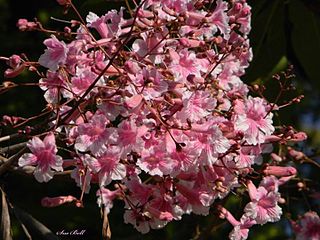
Vachellia tortilis, widely known as Acacia tortilis but now attributed to the genus Vachellia, is the umbrella thorn acacia, also known as umbrella thorn and Israeli babool, a medium to large canopied tree native to most of Africa, primarily to the savanna and Sahel of Africa, but also occurring in the Middle East.

Vachellia erioloba, the camel thorn, giraffe thorn, or Kameeldoring in Afrikaans, still more commonly known as Acacia erioloba, is a tree of southern Africa in the family Fabaceae. Its preferred habitat is the deep dry sandy soils in parts of South Africa, Botswana, the western areas of Zimbabwe and Namibia. It is also native to Angola, south-west Mozambique, Zambia and Swaziland. The tree was first described by Ernst Heinrich Friedrich Meyer and Johann Franz Drège in 1836. The camel thorn is a protected tree in South Africa.

Vachellia nilotica, more commonly known as Acacia nilotica, and by the vernacular names of gum arabic tree, babul, thorn mimosa, Egyptian acacia or thorny acacia, is a flowering tree in the family Fabaceae. It is native to Africa, the Middle East and the Indian subcontinent. It is also considered a 'weed of national significance' and an invasive species of concern in Australia), as well as a noxious weed by the federal government of the United States.

Vachellia constricta, also known commonly as the whitethorn acacia, is a shrub native to Mexico and the Southwestern United States, with a disjunct eastern population in Virginia and Maryland.

Vachellia karroo, commonly known as the Sweet thorn, is a species of Vachellia, native to southern Africa from southern Angola east to Mozambique, and south to South Africa.

Senegalia laeta, the gay acacia or daga, is a legume found in the family Fabaceae. It was formerly included in the genus Acacia.

Vachellia seyal, the red acacia, known also as the shittah tree, is a thorny, 6– to 10-m-high tree with a pale greenish or reddish bark. At the base of the 3–10 cm (1.2–3.9 in) feathery leaves, two straight, light grey thorns grow to 7–20 cm (2.8–7.9 in) long. The blossoms are displayed in round, bright yellow clusters about 1.5 cm (0.59 in) diameter.

Vachellia sieberiana, until recently known as Acacia sieberiana and commonly known as the paperbark thorn or paperbark acacia, is a tree native to southern Africa and introduced into Pakistan. It is used in many areas for various purposes. The tree varies from 3 to 25 m in height, with a trunk diameter of 0.6 to 1.8 m. It is not listed as being a threatened species.

Vachellia xanthophloea is a tree in the family Fabaceae, commonly known in English as the fever tree. This species of Vachellia is native to eastern and southern Africa. It has also become a landscape tree in other warm climates, outside of its natural range.

Vachellia drepanolobium, commonly known as whistling thorn, is a swollen-thorn acacia native to East Africa. The whistling thorn grows up to 6 meters tall. It produces a pair of straight spines at each node, some of which have large bulbous bases. These swollen spines are naturally hollow and occupied by any one of several symbiotic ant species. The common name of the plant is derived from the observation that when wind blows over bulbous spines in which ants have made entry and exit holes, they produce a whistling noise.

Eperua is a genus of flowering plants in the legume family, Fabaceae. It belongs to the subfamily Detarioideae. The fifteen species belonging to this genus are distributed in the tropical zones of Africa and South America, living in the jungles, often along rivers or streams. The leaves are compound pinnate, with smooth margins, and the fruits are long pods. The wood of E. falcata is called wallaba and is often used in construction.

Cordia sinensis is a species of flowering tree in the borage family, Boraginaceae. The species’ range extend from South Africa, through East Africa, Madagascar, West Africa and the Middle East to the Indian Subcontinent and Eastern Indochina. There is also a disjunct native population in Senegal. The species has become naturalised in Eastern Australia. Common names include grey-leaved saucer berry, grey-leaved cordia, marer, mnya mate, mkamasi and tadana.

Vachellia reficiens, commonly known as red-bark acacia, red thorn, false umbrella tree, or false umbrella thorn, is a deciduous tree or shrub of the pea family (Fabaceae) native to southern Africa, often growing in an upside-down cone shape and with a relatively flat crown.

Vachellia flava, synonym Acacia ehrenbergiana, is a species of drought-resistant bush or small tree, commonly known as salam in Arabic. It is found in the Sahara, the northern Sahel, parts of East Africa, the Arabian Peninsula and Iran.

Vachellia abyssinica, the flat top acacia, is a tree up to 16 m tall.

Acacia fulva, known colloquially as velvet wattle or soft wattle, is a species of Acacia native to eastern Australia.

Stereospermum kunthianum is an African deciduous shrub or small tree occurring in the Democratic Republic of Congo, Djibouti, Eritrea, Ethiopia, Kenya, Malawi, Senegal, Somalia, Sudan, Tanzania and Uganda. It is widespread across Africa to the Red Sea, and reaches as far south as Angola, Mozambique, Zambia and Zimbabwe. There are some 30 species with a Central African and Asian distribution.

Elephantorrhiza burkei, commonly known as the elephant root or sumach bean, is a deciduous shrub or small tree in the mimosoid clade of legumes. It is native to southern Africa, where it is found on rocky slopes or ridges, in either woodland, grassland or scrubland. The species is named after the botanist Joseph Burke.
Piliostigma reticulatum is a legume in the Cercidoideae subfamily. It occurs throughout western tropical Africa to Ethiopia.
Anthonotha macrophylla is a shrub to small understory tree within the Fabaceae family. It is endemic to the rain forest regions of West Africa and it is the most common of species within the Anthonotha genus in Africa.

















